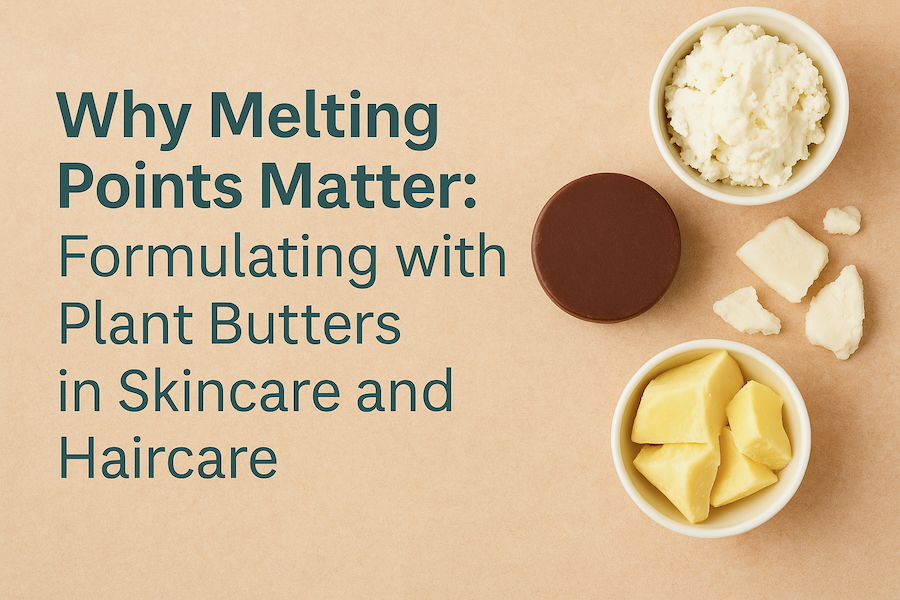Formulating with Plant Butters in Skincare and Haircare
Plant butters are staples in natural cosmetic formulations. Shea butter, cocoa butter, mango butter, kokum butter, and many others contribute creaminess, viscosity, stability, and skin-softening properties. One important characteristic formulators must understand when working with butters is their melting point.
Melting points affect not only the performance of the butter itself but also the texture, stability, and viscosity of the final formulation. Ignoring melting points can result in unstable emulsions, grainy textures, or products that separate in warm or cold conditions.
What Is the Melting Point of Plant Butters?
The melting point is the temperature range at which a butter transitions from solid to liquid. Most plant butters don’t have a sharp melting point but instead soften and melt gradually over a range of temperatures due to their complex fatty acid and triglyceride composition.
-
High melting point butters (like cocoa butter or kokum butter) are firm at room temperature, adding body and rigidity to formulations.
-
Medium melting point butters (like shea or mango) strike a balance, contributing creaminess and spreadability.
-
Low melting point butters (like cupuaçu or murumuru) are softer and more emollient, quickly melting into the skin or hair.
Why Cosmetic Formulators Must Consider Melting Points
1. Stability in Different Climates
Products shipped or stored in warmer regions may soften, leak, or destabilize if formulated with too many low-melting-point butters. Conversely, products stored in colder climates may become too hard or difficult to spread if high-melting-point butters dominate.
2. Control of Viscosity and Texture
Melting points influence the viscosity of creams, lotions, and balms. High-melting butters thicken emulsions and provide structure, while lower-melting butters enhance softness and glide. A balanced combination gives the desired consistency without compromising stability.
3. Product Performance on Skin and Hair
The way a butter melts on contact with skin or hair affects absorption, feel, and functionality. A softer butter creates immediate slip and emollience, while a harder butter offers longer-lasting occlusion.
4. Prevention of Graininess
Some butters, like shea, are prone to crystallization if not melted and cooled properly. Knowing their melting and crystallization behavior helps formulators avoid grainy textures in balms, body butters, and conditioners.
Examples of Plant Butter Melting Points
| Plant Butter | Approx. Melting Point (°C) | Characteristics in Formulation |
|---|---|---|
| Cocoa Butter | 93.2-104°F / 34–38°C | Hard, brittle, adds firmness and stability |
| Kokum Butter | 100.4-104°F /38–40°C | Very firm, excellent for structure |
| Shea Butter | 87.8-100.4°F / 31–38°C | Soft, creamy, prone to crystallization |
| Mango Butter | 82.4- 96.8°F/ 28–36°C | Creamy, light, improves spreadability |
| Murumuru Butter | 86-96.8°F / 30–36°C | Silky, melts quickly, adds slip |
| Cupuaçu Butter | 86-95°F / 30–35°C | Soft, highly emollient, retains water |
| Illipe Butter | 98.6-107.6 / 37–42°C | Firm, smooth, long-lasting emollience |
Note: Exact melting points vary slightly depending on source, processing, and storage.
Key Formulating Notes for Cosmetic Formulators
Understanding melting points is essential for designing stable, climate-resistant, and luxurious formulations. By carefully balancing butters with different melting ranges, formulators can:
-
Achieve desired product consistency and viscosity
-
Ensure stability during storage and shipping
-
Enhance consumer experience with better texture and performance
In short: Melting points are not just number, they are a roadmap to creating stable, effective, and enjoyable hair and skincare products.
Download Formulating with Plant Butters in Skincare and Haircare
🌻🌿Become the Very Best Cosmetic Formulator 🌿🌻
Turn your passion for natural beauty into expertise. Learn how to formulate and create your own professional-quality, plant-based hair and skincare products with professional training in sustainable, natural, and science-based cosmetic formulation.
✨ Start your journey today with Joan Morais Cosmetics School.
👉 Explore Professional Hair Formulation Certification Course
👉 Explore Professional Skin Formulation Certification Course
You might also like


